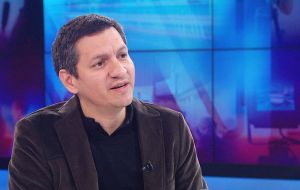MercoPress. South Atlantic News Agency
Calved glacier on the loose in south Chile threatening local ship navigation
 An iceberg measuring some 350 by 380 meters broke from the Grey glacier in far southern Chile in late November, surprising local scientists who monitor the glacier.
An iceberg measuring some 350 by 380 meters broke from the Grey glacier in far southern Chile in late November, surprising local scientists who monitor the glacier.  “Events like this are part of a short-term irreversible tendency” due to rising global temperatures, said Raul Cordero, from the Universidad de Santiago.
“Events like this are part of a short-term irreversible tendency” due to rising global temperatures, said Raul Cordero, from the Universidad de Santiago.  The iceberg now seems like a large chunk of ice, “but it will become a threat” since it will move out to sea and break up into smaller pieces, said Ricardo Jana
The iceberg now seems like a large chunk of ice, “but it will become a threat” since it will move out to sea and break up into smaller pieces, said Ricardo Jana The recent calving of a large iceberg from a southern Chilean glacier threatens local ship navigation and could result in flooding for coastal communities, experts said. An iceberg measuring some 350 by 380 meters broke from the Grey glacier in far southern Chile in late November.
The size of the break surprised local scientists who monitor the glacier.
“Events like this are part of a short-term irreversible tendency” due to rising global temperatures, said Raul Cordero, a climate change expert at the Universidad de Santiago.
The iceberg now seems like a large chunk of ice, “but it will become a threat” since it will move out to sea and break up into smaller pieces, said Ricardo Jana, a glaciologist at the Chilean National Antarctic Institute.
Given its size, the smaller icebergs likely to break off can create problems for area navigation, Jana said.
The icebergs will also contribute to a rise in the sea level, “putting coastal communities at risk for possible flooding,” Jana said.
The Grey glacier is located at the Torres del Paine National Park, some 3,200 kilometers (2,000 miles) south of the capital Santiago.
Over the past 30 years the glacier — now measuring some 270 square kilometers — has lost about two square kilometers of ice.
The glacier is part of the Southern Patagonia Ice Fields, the third largest land-based ice field after Antarctica and Greenland. The Ice Fields straddle southern Chile and Argentina.




Top Comments
Disclaimer & comment rules-

-

-

Read all commentsThis “ glaciolologist” is completely full of shite on this one. And his name is not Jana but Jaña. I have read his work and frankly he's clueless, but says all the right politically correct things.
Dec 04th, 2017 - 08:42 pm +1Do yourself a favour and look at a map of the location of the inland lake on which this iceberg is located. Now calculate how far it is from the closest ocean. Let's say it's about 40 km down narrow rivers to an estuary at the end of a fjord which is itself over 40 km from open, navigable water.
Now zoom in on the little tiny stream that serves to empty Lago Grey.
If you were familiar with the territory, you'd know that this Río Grey is just a little over one metre deep where it leaves the lake, and only a few metres wide. But we are supposed to believe that large icebergs can somehow travel ( fly?) past this restriction to an additional restriction at the little auto bridge over this river, which would also prevent any substantial ice from traveling downstream.
A friend of mine in Chile who works for INACH got in touch with them today to see WTF this is about. It turns out that almost all the ice calving from the Grey glacier gets grounded in shallow waters of the lake well before reaching the outlet. Occasionally, but rarely, a small piece of ice goes downstream and is observed by operators of kayaks and inflatables on the Serrano River. And this is the basis for the wild and baseless speculation that there might be interference with “navigation.” When pressed on the meaning of “navigation” it turns out that the Chilean who prepared the report likes to think of “navigation” not in English terms but instead as the passage of a kayak down a narrow rapids-filled river -- which would in English be described as nonnavigable ( 'term that applies to bodies of water that a ship is unable to pass through.')
Bad translation, junk science, fake news.
@ Tinkle “Geeeeeeeeeeeeeee....”
Dec 05th, 2017 - 03:33 am +1-----
It's so obvious that even a pseudo argie might understand it.
The baby icebergs in that tinkle video were in the same place where icebergs are grounded every year -- anything of that size just can't get into the shallow river. That chilean glaciologist Jaña is clearly an idiot.
Dec 05th, 2017 - 02:13 pm +1This image shows the “zona de iceberg ” where those bergy bits are blown and stuck. You can then follow the course of that little river (Río Grey) as it meanders for dozens of km down to the Serrano River, where even the smallest pieces quickly disintegrate.
http://www.tutravesia.com/imagen/rio_serrano/Rio%20Grey.jpeg
And there is no fooking way this iceberg is going to cause “flooding in coastal communities.”
Black Eye Award for the Chilean Antarctic Institute.
Another view of that shallow river... imagine the sort of “navigation” possible here.
https ://photos.travelblog.org/Photos/13426/181213/f/1342954-Rio-Grey-0.jpg
Commenting for this story is now closed.
If you have a Facebook account, become a fan and comment on our Facebook Page!